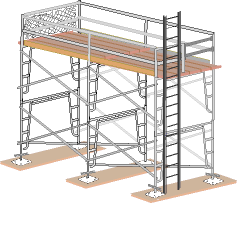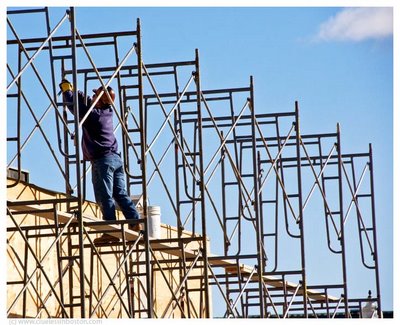Discover Leading Scaffolding Near Me for Your Home or Business Needs
Discover Leading Scaffolding Near Me for Your Home or Business Needs
Blog Article
A Comprehensive Overview to the Important Functions of Scaffolding in Modern Building And Construction
The landscape of modern-day building increasingly counts on efficient scaffolding systems that focus on advancement, security, and efficiency. As jobs expand in intricacy, comprehending the vital features of scaffolding comes to be essential for making certain worker safety and optimizing project timelines. This overview checks out different kinds of scaffolding, highlights crucial security functions, and analyzes product advancements that add to performance and sustainability. Nonetheless, the ramifications of these aspects expand much past mere building practices, prompting a better consider exactly how they affect general task success and worker wellness.
Sorts Of Scaffolding
Although scaffolding systems can vary widely in design and application, they usually fall under a number of unique groups that deal with various building needs - Scaffolding. The most usual types include supported scaffolding, suspended scaffolding, and rolling scaffolding
Sustained scaffolding includes platforms supported by a structure of poles, which give a raised and steady functioning surface. This kind is generally made use of for tasks that call for considerable altitude, such as bricklaying or outside painting.
Put on hold scaffolding, on the other hand, is used for tasks requiring accessibility to high altitudes, such as cleaning or repairing structure facades. This system hangs from another structure or a rooftop, permitting workers to reduced or elevate the platform as needed.
Rolling scaffolding functions wheels that enable simple wheelchair across a work website. It is specifically valuable for jobs that need regular relocation, such as indoor operate in big spaces.
Each kind of scaffolding is designed with specific applications in mind, making sure that building projects can be performed successfully and successfully. Understanding these categories is essential for selecting the suitable scaffolding system to meet both project needs and website conditions.
Trick Security Features
Safety is critical in scaffolding systems, as the possible risks related to operating at heights can cause significant accidents otherwise appropriately managed. Key safety and security functions are important to make sure the well-being of workers and the honesty of the building and construction website.
Primarily, guardrails are critical. These barriers provide a physical safeguard against drops, substantially reducing the danger of major injuries. In addition, toe boards are usually utilized to stop devices and products from dropping off the scaffold, shielding workers below.
Another vital part is the usage of non-slip surface areas on systems. This attribute boosts grasp, specifically in damaging weather, thereby reducing the possibility of slips and drops. Accessibility ladders should be firmly positioned to assist in safe entry and exit from the scaffold.
Regular evaluations and maintenance of scaffolding systems are likewise vital. These assessments make sure that all components are in good condition and working properly, dealing with any kind of wear or damages without delay.
Last but not least, appropriate training for all personnel associated with scaffolding procedures is vital to guarantee that they understand safety methods and can identify prospective dangers. Scaffolding. Collectively, these functions develop a more secure working environment and dramatically mitigate threats related to scaffolding
Material Innovations
Improvements in material science have actually considerably influenced the scaffolding industry, enhancing both security and efficiency in contemporary building and construction. The introduction of high-strength steel and aluminum alloys has transformed typical scaffolding systems. These materials are not just lighter, making them less complicated to transport and set up, but additionally supply premium load-bearing abilities. This causes scaffolding frameworks that can support higher weights while minimizing the threat of collapse.
Additionally, cutting-edge composite products, such as fiberglass-reinforced plastics, have actually emerged as practical options. These products are immune to corrosion and environmental deterioration, therefore expanding the life-span of scaffolding systems, especially in severe weather condition conditions. Using such materials contributes to lower maintenance prices and ensures regular performance gradually.


Layout Factors To Consider
Considering the intricacies of contemporary construction jobs, effective scaffolding layout is extremely important to making certain both performance and security. Style considerations need to include numerous aspects, including tons capability, height, and the particular requirements of the building and construction site. Each job presents distinct challenges, necessitating a versatile strategy to scaffolding systems that can adapt to varying conditions.
Structural honesty is essential; as a result, designers need to determine the tons that the scaffolding will support, including employees, materials, and devices. The selection of products plays a crucial duty in making sure the scaffolding can endure these tons while staying resilient and light-weight. Additionally, the style has to allow for easy access and egress, facilitating the smooth motion of materials and personnel.
Safety functions, such as guardrails and non-slip surfaces, need to be incorporated to reduce dangers of accidents. The format needs to think about the surrounding setting, including prospective hazards and surrounding frameworks. By attending to these style factors to consider, building firms can improve the efficiency of scaffolding systems and promote a safer working atmosphere, eventually adding to the total success of the task.
Upkeep and Evaluations
The effectiveness of scaffolding systems extends past first design and execution; ongoing maintenance and normal examinations are crucial to ensuring their continued performance and safety and security throughout the duration of a task. Regular examinations must be performed by certified personnel to determine any kind of signs of wear, damage, or instability that can endanger the stability of the scaffolding.
Upkeep procedures ought to include regular checks of structural components, such as frameworks, slabs, and fittings, making certain that all elements remain secure and totally free from rust or various other damage. Furthermore, the functionality of safety and security functions, such as guardrails and toe boards, have to be examined to make sure compliance with safety and security guidelines.
Paperwork of all examinations and maintenance tasks is critical for liability and regulative conformity. An organized strategy to record-keeping not just help in tracking the condition of the scaffolding however likewise gives needed proof in the event of a case.
Inevitably, developing a comprehensive upkeep and inspection schedule will considerably minimize the risk of crashes and boost the total safety and security of the building website. By scaffolder fined prioritizing these practices, construction supervisors can protect employees and copyright the job's honesty.

Verdict
Finally, the essential attributes of scaffolding in modern-day building include a variety of critical aspects, consisting of diverse kinds, crucial safety and security devices, material technologies, and thoughtful style factors to consider. Emphasizing security through guardrails and non-slip surface areas, along with improvements in materials like high-strength steel, improves both efficiency and sustainability. In addition, regular upkeep and inspections are crucial for ensuring structural honesty and security on building and construction sites, ultimately promoting efficient job implementation and advertising the well-being of workers.
The landscape of modern building significantly counts on effective scaffolding systems that focus on safety and security, efficiency, and technology.Innovations in product scientific research have actually dramatically affected the scaffolding sector, boosting both security and effectiveness in contemporary building. In general, these material innovations not only enhance the efficiency and safety and security of scaffolding systems yet additionally straighten with the market's press towards sustainability, as lots of contemporary materials are developed to be more eco pleasant.
Thinking about the complexities of modern construction jobs, effective scaffolding design is try this out vital to making sure both functionality and safety and security.In final thought, the important attributes of scaffolding in contemporary construction incorporate a variety of critical aspects, including varied types, crucial safety devices, material technologies, and thoughtful style considerations.
Report this page